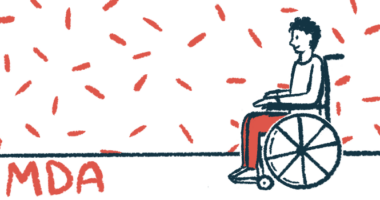Scholar Rock Shares Design of Phase 3 SAPPHIRE Trial of Apitegromab

Scholar Rock announced the full design of the upcoming Phase 3 clinical trial testing apitegromab, its experimental muscle-directed therapy for spinal muscular atrophy, in children and young adults with types 2 and 3 SMA who are unable to walk.
Apitegromab will be given as an add-on therapy to either Spinraza (nusinersen) or Evrysdi (risdiplam), two SMA disease-modifying therapies (DMTs) approved in the U.S. and Europe.
The global trial, called SAPPHIRE, plans to enroll patients across 55 sites, including in the U.S. and Europe, and recruitment is expected to start in the upcoming months. Study start-up activities are underway.
“Despite the important progress in SMA treatment offered by [SMN-boosting] therapies, there continues to be significant unmet medical need, and we believe that apitegromab has the potential to improve motor function as add-on to background SMN therapy and transform the lives of patients with SMA,” Nagesh Mahanthappa, PhD, Scholar’s interim CEO, said in a press release.
Apitegromab, infused directly into the bloodstream every four weeks, is designed to increase muscle strength and function in SMA patients by selectively preventing the generation of the active form of myostatin, a protein that suppresses muscle growth.
As a muscle-directed therapy, its mechanism of action is distinct from currently approved DMTs for SMA, all of which work by increasing the levels of SMN, a protein essential for motor neuron and muscle health and whose production is impaired in SMA patients.
“We are encouraged and motivated by the positive results of the TOPAZ Phase 2 proof of concept trial, which informed the design of SAPPHIRE to evaluate the therapeutic potential of apitegromab in SMA,” said Yung Chyung, MD, Scholar’s chief medical officer. “Building on the solid foundation of TOPAZ, our Phase 3 trial and the broader program are aimed at advancing the development of apitegromab towards our aspiration of transforming the lives of patients with SMA.”
The Phase 2 TOPAZ trial (NCT03921528) evaluated the one-year safety and effectiveness of two doses of apitegromab (2 and 20 mg/kg) in 58 children and young adults, ages 2 to 21 years, with SMA type 2 or 3.
Results showed that apitegromab led to improvements in motor function, as measured by the Hammersmith functional motor scale expanded (HFMSE). Higher HFMSE scores indicate better motor abilities, and a score change of at least three points is considered clinically meaningful.
Notably, the greatest increases in HFMSE scores were observed with the higher dose (20 mg/kg) and among patients who were unable to walk (non-ambulatory).
An exploratory post-hoc analysis of 16 non-ambulatory children (ages 2–12) on Spinraza who were treated for one year with apitegromab at its higher dose found a mean increase of 4.4 points in the HFMSE score, Scholar Rock reported in its release.
Specifically, 81% of them had a one-point or greater increase in the HFMSE score, and more than half (56%) achieved clinically meaningful gains.
Based on these findings, SAPPHIRE’s main analysis will test both the higher (20 mg/kg) and an additional intermediate dose (10 mg/kg) of apitegromab against a placebo in up to 156 non-ambulatory children, ages 2–12 years, with SMA type 2 or 3.
As an exploratory patient population, up to 48 non-ambulatory adolescents and young adults (ages 13–21) with SMA type 2 or 3 will also be recruited and randomly assigned to either 20 mg/kg of apitegromab or a placebo.
All participants will have to be on stable DMT for at least 10 months in the case of Biogen’s Spinraza and at least six months in the case of Roche’s Evrysdi prior to enrollment. Those treated with Novartis’ gene therapy Zolgensma (onasemnogene abeparvovec), another approved DMT for SMA, will not be eligible.
As in TOPAZ, SAPPHIRE’s main goal will be to assess changes in HFMSE after one year of treatment. Secondary goals include the proportion of patients achieving clinically meaningful HFMSE changes, and changes in upper limb function and motor developmental milestones.
The therapy’s pharmacokinetics (movement into, through, and out of the body) and pharmacodynamics (effects on the body) will also be assessed, as well as safety measures, and immune reactions against the therapy.
An interim analysis is planned for when at least 50% of participants in the younger age group (2–12 years) have finished the one-year treatment.
After completing the SAPPHIRE trial, participants will have the option of enrolling in an open-label extension study, in which all will receive the experimental therapy for a longer period.
As of Nov. 30, 55 of the 57 patients who completed TOPAZ are still in that trial’s extension study and being followed, the company noted.
Recognizing that not every SMA patient will be eligible to participate in SAPPHIRE, Scholar in a letter to the community emphasized that conducting a trial “with a well-defined and similar group of individuals gives the best chance to get strong and conclusive data, which is important in seeking approval from regulatory agencies expeditiously.”
The company also noted that it expects to explore the use of apitegromab in patient populations not included in this trial in the future.








